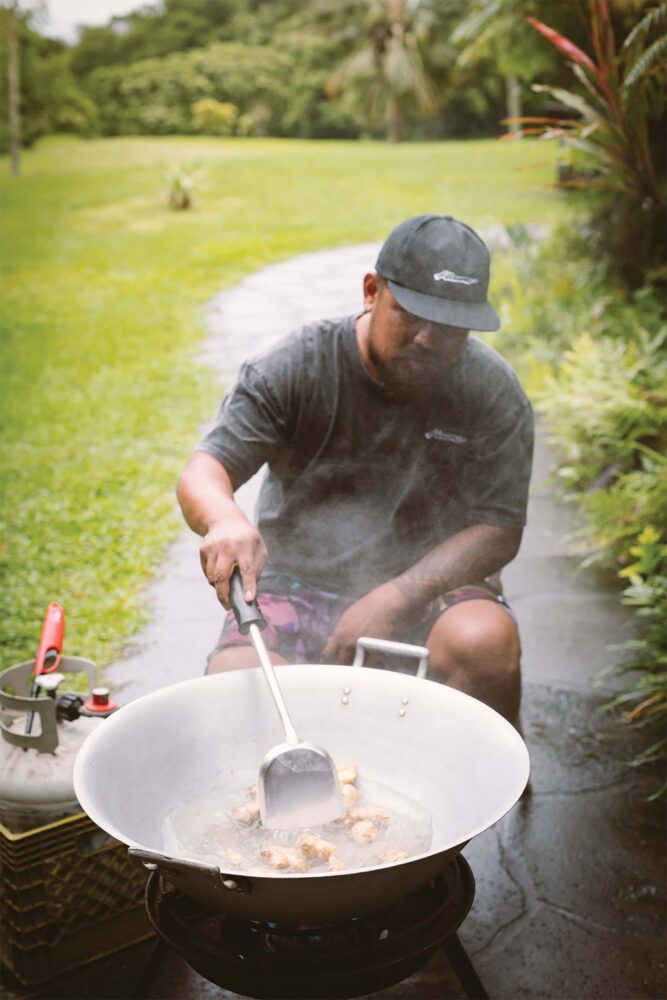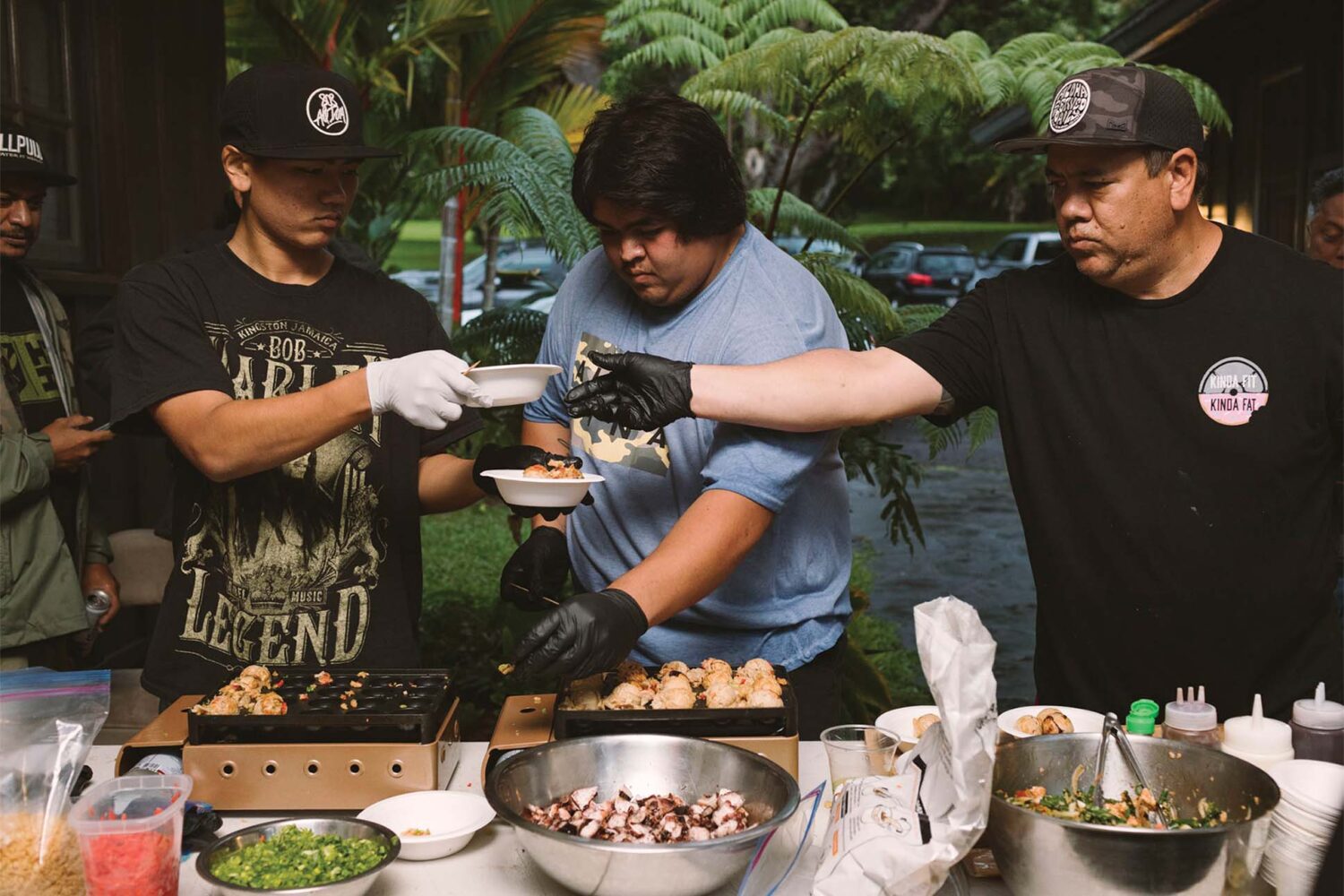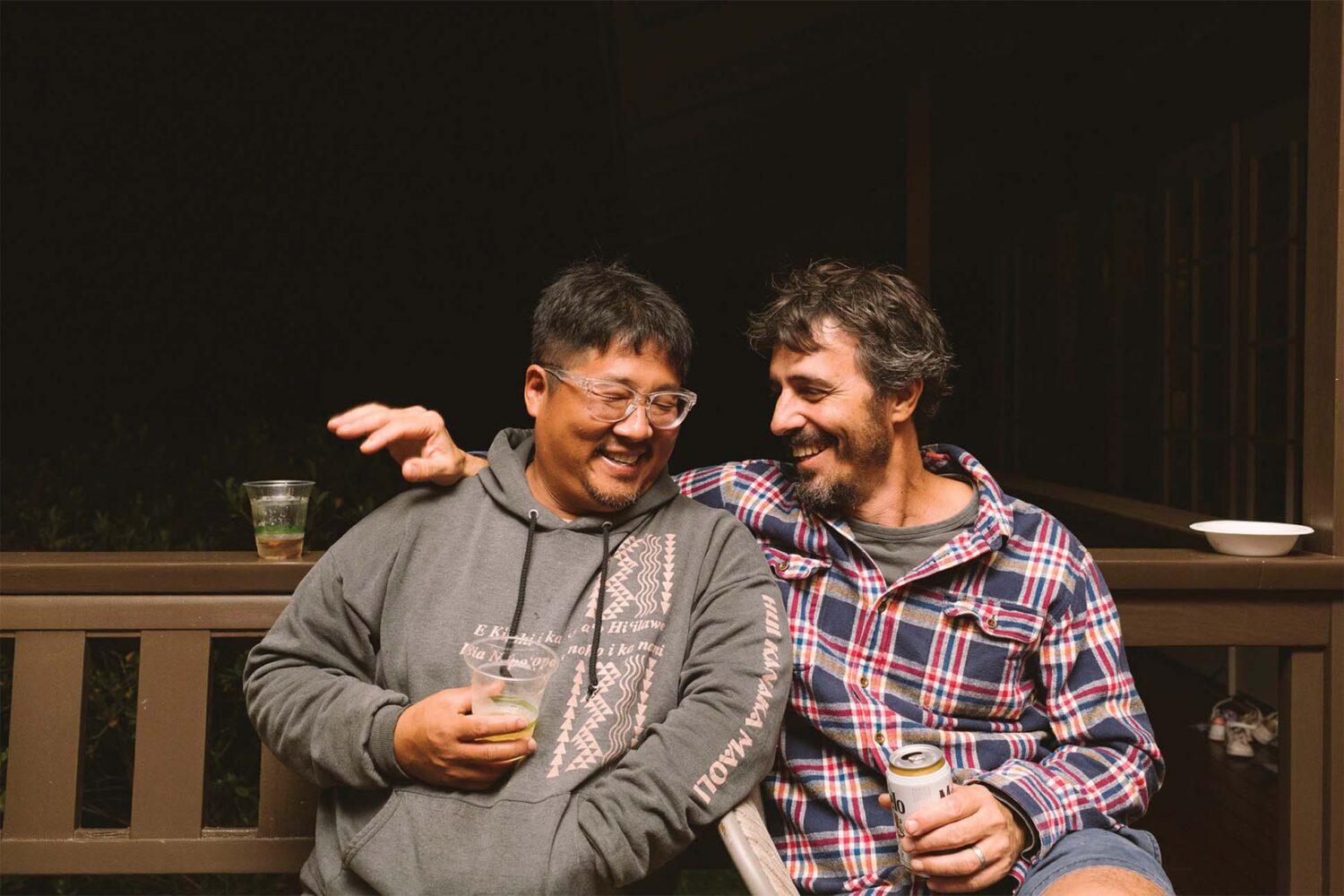A cadre of illustrious chefs come together with an East Maui community where the kua‘āina lifestyle persists.
On a rainy weekend this past spring, six Hawai‘i chefs gathered in Hāna to reconnect with the hunters, fishermen, and farmers of East Maui. These two groups — acclaimed chefs and everyday hunter-gatherers — embarked on what might have initially appeared to be an unlikely friendship when they first met in 2016. But their meeting was initiated by Ala Kukui, a Native Hawaiian-run retreat center in Hāna that privileges engagement with the immediate local community first and foremost. Hāna Kū, one of Ala Kukui’s main programs, brings these two groups of men together to integrate and deepen their practice and heighten their self awareness through holoholo, cooking together, and talking story into the night.
The impressive cast of chefs at its most recent gathering included Oʻahu’s Mark Noguchi of Pili Group and Dave Caldiero of Mud Hen Water and Kaimuki Superette; Maui’s Isaac Bancaco of Pacific’o on the Beach; Sheldon Simeon of Tin Roof; Kyle Kawakami of Maui Fresh Streatery; and Bella Toland, formerly of Banyan Tree and Hāna’s Travaasa Hotel.
Their day started with lending their kōkua to a new conservation site. Braving the rain, the chefs and local families cleared recently felled invasive trees, collecting armfuls of trunks and branches and throwing them in a wood chipper until the machinery had had enough and sputtered to a stop.
From there, they walked down to the coast to talk story and learn about the newly conserved land, and efforts to return it to community stewardship. In recent years the former ranch land was at risk of private ownership until Hāna residents formed a nonprofit that secured state, county, and private funding to purchase the parcel, designating it conservation land and ensuring the continuance of subsistence practices, namely fishing and gathering, on the coastal strip of the ahupuaʻa for future Hāna generations.
There are food festivals all over the world, and there’s nothing like Hāna Kū.
Mark Noguchi, chef


“There are food festivals all over the world, and there’s nothing like Hāna Kū,” Mark Noguchi said, looking around at the families gathered to hear a Hāna kupuna speak about the history and recent threats to the ground he stood on.
It was Noguchi’s sixth year coming to Hāna to meet with Kauʻi Kanakaʻole, her husband Ioane Park and other Hāna kanaka. Kanakaʻole, who runs Ala Kukui, wanted to bring Hāna men together with like-minded Hawaiʻi chefs who elevate food in the islands with respect for ‘āina and Hawaiian traditions.
To the right of Noguchi stood Naihe Akoi, a broad-shouldered, 35-year-old Hāna hunter and fisherman and father of four. It was Akoi’s third time at Hāna Kū, and his wife Poha and their two oldest children, Naihe Boy and Waianuhea, kept up with the laborious volunteer work all morning. For Naihe, there is no separation between his day-to-day life and the ‘āina and traditions the present chefs seek to perpetuate respect for in their work.
“It’s about unbroken generational knowledge,” Kanakaʻole said, explaining that she wanted to highlight Hāna hunters and fishermen and the knowledge they’ve passed down for centuries. She spoke to her Hilo cousin, the cultural practitioner and graphic designer Kūhaʻo Zane, and together they explored the question: “How can we elevate hunting and fishing as an intelligence that is place-based, family-specific, and can’t be taught in any school?”
Before the pandemic, Ala Kukui and the Hāna Kū chefs would put on an annual fundraiser that highlighted the participating Hāna hunters and fishermen, and the chefs, who each had a station offering a signature dish. At a July 2019 event, Kanakaʻole and her hula hālau, Hālau o Nakaulakuhikuhi, performed a flourish of sophisticated ʻauana dances. The party, which delighted guests and secured funds for future programs, represents the more widely known public-facing side of Hāna Kū. But the more intimate weekends, when twice a year the chefs came to Hāna to holoholo with a family with a long lineage in the remote, sparsely developed town, have always been the fulcrum of Hāna Kū.


Hāna is the perfect setting for a group of chefs to embrace one another, having left the stress and hyper-competitiveness of their industry somewhere along the 50-mile, two-lane highway that weaves between oceanside drop offs and tree-laden rock face. It is a place, protected by its remoteness and the conviction of its community, where Hawaiian families supplement their store-bought groceries with a subsistence lifestyle, as they did generations ago. “Hāna — it just speaks to you, it’s a reset,” said Simeon. “And Hāna Kū is a safe space where I can be completely vulnerable and share and cut loose.”
The chefs stay at Ala Kukui and a Hāna family takes them on excursions and cooks with them, and they really get to know one another, Kanakaʻole explained. These holoholo include hunting boar, pole fishing by boat, spearfishing along the shore, and gathering prawns in streams. Later they gather at the Ala Kukui kitchen and prepare a feast together, the chefs sharing the tricks of their trade, and the hunters and the Hāna men showing theirs. Naihe, for one, makes a mean sausage from the boar he hunts in the East Maui mountains. Last fall, chef Leanne Wong, of the Lahaina restaurant Papa ʻĀina, made succulent akule dumplings from a bounty of small fish caught at Hāna Bay in the days before she and the other chefs arrived.
“And after they cook, we talk story,” said Kanakaʻole. The chefs at Hāna Kū are not just any chefs; they are Hawaiʻi chefs working to cultivate an appetite for Hawaiʻi-grown foods rich with history and cultural relevance. Their menus, whether at five-star hotels or fan-favorite food trucks, have a sense of place that hints at the rich multiculturalism of Hawaiʻi, and are a pointed departure from the tourism-forged imported palate of the islands’ recent past. At the fall session, after Wong’s akule dumplings had been happily devoured, the group sat on the floor around an ʻawa bowl and Park served the native drink as the men spoke about how they could deepen their practice. The topic of how one’s practice makes one Kanaka surfaced.
Bancaco, who grew up spearfishing with his family in Maui waters, has found esteemed homes for his food philosophy. At Andaz Maui, he sourced around 85 percent of ingredients locally (the inverse of the percentage of food that Hawaiʻi imports), and Pacific’o on the Beach, where he is now the head chef, has its own farm in Kula, the Upcountry area where he grew up.
The five-year Hāna Kū alum points out that precontact Hawaiians sustained themselves within a one-mile radius: hunting, fishing, farming, and gathering from within their ahupuaʻa and making full use of their resources. These are perhaps tenets of Bancaco’s cooking that make him a Kanaka in his daily life. In his cooking, he often supplants the umami burst typically given by anchovy with salted and cured ‘ahi blood line — a nutrient-rich part of the fish that the vast majority of chefs discard.


Bancaco said his childhood was not steeped in traditional aspects of the culture that one might think of as Hawaiian: he never learned to dance hula and his parents did not speak ʻōlelo Hawaiʻi in the home. “For me, being Kanaka, being Hawaiian, in today’s Hawaiʻi is more about contributing to the community and being a part of what we know as Hawaiʻi today.”
After garnering acclaim as a chef at Oʻahu’s He‘eia Kea Pier General Store and Deli and with his catering company Pili Group, Mark Noguchi is now focusing his energy on developing food and ʻāina based curriculum at Punahou School. A second generation Hawaiʻi-born Japanese chef, Noguchi highlights the nuance of Hawaiʻi’s multiculturalism and the pride to be found in connection with one’s birthplace while owning a separate ancestry. “What I think Hāna Kū does for me is it reinforces my pride in who I am and where I came from,” he said.
Noguchi was part of the original Hāna Kū clan in 2015, having met Kanakaʻole while dancing hula on Hawaiʻi Island in the mid-‘90s. Over the years he has come to know the East Maui families who live off the land there and he said he has seen first hand the impact the Hāna men and chefs who’ve come over the years have had on one another.
For me, being Kanaka, being Hawaiian, in today’s Hawaiʻi is more about contributing to the community and being a part of what we know as Hawaiʻi today.
Isaac Bancaco, chef
“Naihe started his own tree-pruning business in the last few years, and I think Hāna Kū helped to give him the confidence to do that,” Noguchi said. “Hanging out with chefs from the city, from town, I think it showed that you can expand your life, your work, your business, and still be a local braddah. That seeking more for your family does not make you less kuaʻāina.”
At Kawakami’s first Hāna Kū in 2018, he woke up at 5 a.m. to slaughter and butcher a cow with the Parks, a multigenerational Hāna family of ranchers and fishermen. “That was a first for me and I still remember it and appreciate the process and what I learned that day. I’ve learned something new every time I go out to Hāna, from the other chefs and from the Hāna guys,” Kawakami said.


This past spring at Hāna Kū, Kawakami and his son made takoyaki, a playful Japanese street food, from octopus they caught diving off the Hāna coast. His son twirled the batter, octopus, and green onion with skewers in spherical tins until the mixture was transformed into orbs of succulent umami-rich flavor bombs topped with bonito flakes that curled from the heat, Kewpie mayo, and unagi sauce.
To complement the takoyaki, Kawakami made a pohole salad with a Laotian spice mix and prawns that Park plucked from a Hāna stream earlier in the week. “I had to go to the stream twice,” Park explained. “The first night it rained and it was difficult to see the eyes glowing with the rain drops pelting the surface of the water.”
Noguchi made white chicken chili, his wife’s grandmother’s recipe, that he topped with nori-dusted oyster crackers. Caldiero used sour oranges from the Ala Kukui grounds to make escabeche with uku that Bancaco brought, and served it with lightly pickled local vegetables and fresh sourdough bread he brought over from Oʻahu’s Breadshop, a craft bakery in Kaimukī. Simeon prepared tripe in the style of Portuguese bean soup. One of the Hāna families made Hawaiian-style pork and beans, and Keliʻi Heen, managing partner of Argex Beverages and cocktail extraordinaire, kept the citrus cocktails flowing.
Gathered around the ʻawa bowl, Naihe said to the chefs that he has come to know over the years, “You guys have inspired me to look deeper. There is always something deeper, in people, in practices. I want to mahalo you guys for valuing the holoholo practitioner.” Then addressing the circle, he thanked the chefs for sharing a “just charge, no be scared” mentality that encouraged Naihe to step into new frontiers professionally. “Looking at these guys, we have all kinds of success stories around here,” he said with deference. The Hāna guys are accomplished in their own right, from Naihe and his tree trimming operation to Kīpahulu-born Greggie Lind and his thriving fish business, which sells to chefs like Bancaco but sells the majority of his catch to his own community at reasonable prices.


Kanakaʻole’s hunch that the zealousness of the chefs she invited and the ingrained knowledge the Hāna men possess would bind them has been an undoubted success. Normally a community that justifiably defends its resources against outsiders, the very Hāna men who have depended on these resources all their lives shared their knowledge with and spoke of the chefs affectionately. “If you’re not doing it, you’re learning how to do it, I respect that,” said Biggie Smith, who grew up fishing down the road in Waikoloa.
Around the ʻawa bowl, Caldiero, who grew up in New York, recalled a humbling learning experience of his own at his first Hāna Kū in 2018 when the Hāna guys took him and the other chefs to throw net. “I remember Ioane could see the fish and he was about to throw the net, and I’m right there next to him and I can’t see shit,” he said with a laugh, adding that he had “come a long way” in these last four years.
Despite any initial inexperience that chefs like Caldiero might have shown outside the kitchen, the Hāna guys recognized the intelligence they possessed within it. Naihe compared the chefs’ instincts in the kitchen to his own instincts while stalking wild boar or deer in the wilderness. “It isn’t just the training of what to do, it’s how we think,” Naihe said. “To me it’s an art, it’s a state of feeling.”

